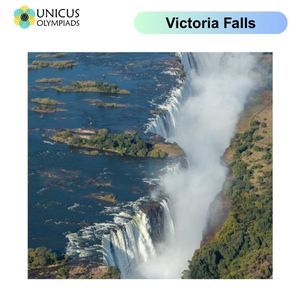

Victoria Falls is one of the most spectacular and awe-inspiring natural wonders in the world, renowned for its immense width and height. It is located on the Zambezi River, which forms the border between two countries in Southern Africa. In this article, we will explore the geographical location of Victoria Falls, the countries it spans, and its cultural, ecological, and tourism significance.
Victoria Falls is situated on the Zambezi River, which forms the border between Zimbabwe and Zambia, two countries in Southern Africa. The falls are located about 1,700 meters (5,577 feet) above sea level and are part of the Zambezi River basin. The falls are positioned between the towns of Livingstone in Zambia and Victoria Falls in Zimbabwe.

Victoria Falls is unique because it spans the international border between two countries, making it a natural landmark of shared heritage. The falls are divided by the Devil's Cataract, the largest section of the falls, which separates the two countries. The main waterfall lies mostly in Zimbabwe, while the Gorge and Island areas are shared between both Zambia and Zimbabwe.
Zimbabwe is home to the majority of the falls and is the primary access point for tourists who wish to visit the most popular viewpoint. The Zimbabwean side of Victoria Falls is known for offering panoramic views of the falls, and it is located in the Victoria Falls National Park, which is a UNESCO World Heritage Site. The town of Victoria Falls is located just 10 kilometers from the falls, making it the gateway for visitors from Zimbabwe. Visitors on the Zimbabwean side have access to walking tours, a rainforest trail, and a series of observation platforms that provide unparalleled views of the falls.
Zambia, on the other hand, offers a closer, more intimate experience of the falls. The Zambian side is famous for its Livingstone Island, where visitors can stand at the very edge of the falls during the dry season and even experience the Devil’s Pool, a natural pool located right on the edge of the waterfall. This side of the falls also offers access to the Victoria Falls Bridge, which spans the gorge and connects the two countries. The town of Livingstone in Zambia is the nearest town to the falls on this side, and it serves as the primary entry point for visitors from Zambia.
Victoria Falls is considered one of the largest and most impressive waterfalls in the world. It is 1,708 meters (5,604 feet) wide, making it the largest waterfall in the world by width. It has a height of about 108 meters (354 feet), which is roughly double the height of Niagara Falls. The waterfall is divided into five main sections: the Devil’s Cataract, the Main Falls, the Rainbow Falls, the Horseshoe Falls, and the Eastern Cataract.
Victoria Falls is fed by the Zambezi River, which is the fourth-largest river in Africa. The volume of water flowing over the falls varies greatly depending on the season, with the peak flow occurring during the rainy season between March and May. During the dry season, the flow decreases, and visitors can get closer to the falls and even experience activities such as swimming in the Devil's Pool. The mist generated by the waterfall is so powerful that it can be seen from several kilometers away, often creating a “rainbow” effect in the mist during sunny weather.
Victoria Falls is considered one of the Seven Natural Wonders of the World and has been recognized for its exceptional natural beauty and ecological significance. In 1989, it was designated a UNESCO World Heritage Site for its cultural and natural value. The falls are regarded as a sacred site by the local Tonga people, who have long associated the falls with spiritual beliefs and traditions.
Victoria Falls is one of Africa’s premier tourist destinations, attracting over a million visitors annually. The site offers a variety of activities for tourists, including:
Victoria Falls is part of the Zambezi River basin, which supports a wide range of ecosystems and wildlife. The area surrounding the falls is rich in biodiversity, with tropical forests, grasslands, and wetlands that support numerous species of plants and animals. The falls are also a critical water source for the surrounding communities and ecosystems, as the Zambezi River provides water for agriculture, wildlife, and local populations.
The falls hold significant cultural importance for the local communities. For centuries, the falls have been part of the spiritual life of the Tonga people, who refer to the falls as Mosi-oa-Tunya, meaning "The Smoke That Thunders" because of the mist created by the falling water. Local communities perform rituals and ceremonies near the falls, and the site is revered as a sacred place. The name "Victoria Falls" was given to the waterfall by the Scottish missionary and explorer David Livingstone in 1855, in honor of Queen Victoria of Britain.
Victoria Falls faces a number of environmental threats, including pollution, deforestation, and the impact of climate change, which has altered water flow in the Zambezi River. In recent years, conservation efforts have focused on protecting the falls and its surrounding ecosystems. Efforts are being made by both the Zimbabwean and Zambian governments, as well as international conservation organizations, to ensure sustainable tourism and protect the natural environment around the falls.
Both Zimbabwe and Zambia have implemented sustainable tourism practices in order to minimize the environmental impact of visitors. These include managing the number of tourists allowed at the falls each day, promoting eco-friendly accommodations and transportation, and ensuring that local communities benefit from tourism revenues. Additionally, the governments work together to protect the falls' cultural heritage and support local indigenous peoples living near the site.